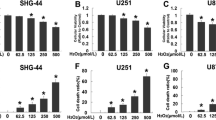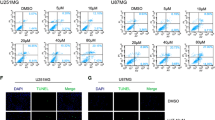Oxidative stress is known to induce cell death in a wide variety of cell types, apparently by modulating intracellular signaling pathways. Activation of extracellular signal-regulated kinase (ERK) in oxidative stress remains controversial. In some cellular systems, the ERK activation is associated with protection against oxidative stress, while in other system, the ERK activation is involved in apoptotic cell death. The present study was undertaken to examine the role of ERK activation in H2O2-induced cell death of human glioma (A172) cells. H2O2 resulted in a time- and dose-dependent cell death, which was largely attributed to apoptosis. H2O2 treatment caused marked sustained activation of ERK. The ERK activation and cell death induced by H2O2 was prevented by catalase, the hydrogen peroxide scavenger, and U0126, an inhibitor of ERK upstream kinase MEK1/2. Transient transfection with constitutive active MEK1, an upstream activator of ERK1/2, increased H2O2-induced cell death, whereas transfection with dominant-negative mutants of MEK1 decreased the cell death. The ERK activation and cell death caused by H2O2 was inhibited by antioxidants (N-acetylcysteine and trolox), Ras inhibitor, and suramin. H2O2 produced depolarization of mitochondrial membrane potential and its effect was prevented by catalase and U0126. Taken together, these findings suggest that growth factor receptor/Ras/MEK/ERK signaling pathway plays an active role in mediating H2O2-induced apoptosis of human glioma cells and functions upstream of mitochondria-dependent pathway to initiate the apoptotic signal.
Similar content being viewed by others
References
S. Love (1999) ArticleTitleOxidative stress in brain ischemia Brain Pathol. 9 119–131
A. Lewen P. Matz P. H. Chan (2000) ArticleTitleFree radical pathways in CNS injury J. Neurotrauma 17 871–890
S. C. Bondy (1995) ArticleTitleThe relation of oxidative stress and hyperexcitation to neurological disease Proc. Soc. Exp. Biol. Med. 208 337–345
R. A. Floyd (1990) ArticleTitleRole of oxygen free radicals in carcinogenesis and brain ischemia FASEB J. 4 2587–2597
C. W. Olanow (1993) ArticleTitleA radical hypothesis for neurodegeneration Trends Neurosci. 16 439–444
M. Sendtner H. Thoenen (1994) ArticleTitleNeurodegenerative disease. Oxidative stress and motorneuron disease Curr. Biol. 4 1036–1039
B. Halliwell J. M. C. Gutteridge C. E. Cross (1992) ArticleTitleFree radicals, antioxidants, and human disease: Where are we now? J. Lab. Clin. Med. 119 598–620
F. Facchinetti V. L. Dawson T. M. Dawson (1998) ArticleTitleFree radicals as mediators of neuronal injury Cell Mol. Neurobiol. 18 667–682
R. M. Friedlander (2003) ArticleTitleApoptosis and caspases in neurodegenerative diseases N. Engl. J. Med. 348 1365–1375
D. M. Hockenbery Z. N. Oltvai X. M. Yin C. L. Milliman S. J. Korsmeyer (1993) ArticleTitleBcl-2 functions in an antioxidant pathway to prevent apoptosis Cell 75 241–251 Occurrence Handle10.1016/0092-8674(93)80066-N
L. J. Greenlund T. L. Deckwerth E. M. Johnson SuffixJr. (1995) ArticleTitleSuperoxide dismutase delays neuronal apoptosis: a role for reactive oxygen species in programmed neuronal death Neuron 14 303–315
J. A. Klein S. L. Ackerman (2003) ArticleTitleOxidative stress, cell cycle, and neurodegeneration J. Clin. Invest. 111 785–793
Y. Kitamura T. Ota Y. Matsuoka I. Tooyama H. Kimura S. Shimohama Y. Nomura P. J. Gebicke-Haerter T. Taniguchi (1999) ArticleTitleHydrogen peroxide-induced apoptosis mediated by p53 protein in glial cells Glia 25 154–164
K. Takuma E. Lee M. Kidawara K. Mori Y. Kimura A. Baba T. Matsuda (1999) ArticleTitleApoptosis in Ca2+ reperfusion injury of cultured astrocytes: roles of reactive oxygen species and NF-kappaB activation Eur. J. Neurosci. 11 4204–4212
K. Takuma A. Baba T. Matsuda (2004) ArticleTitleAstrocyte apoptosis: implications for neuroprotection Prog. Neurobiol. 72 111–127
J. L. Martindale N. J. Holbrook (2002) ArticleTitleCellular response to oxidative stress: Signaling for suicide and survival J. Cell. Physiol. 192 1–15
Z. Xia M. Dickens J. Raingeaud R. J. Davis M. E. Greenberg (1995) ArticleTitleOpposing effects of ERK and JNK-p38 MAP kinases on apoptosis Science 270 1326–1331 Occurrence Handle1:CAS:528:DyaK2MXpsFOhurc%3D Occurrence Handle7481820
M. H. Cobb (1999) ArticleTitleMAP kinase pathways Prog. Biophys. Mol. Biol. 71 479–500
K. Z. Guyton Y. Liu M. Gorospe Q. Xu N. J. Holbrook (1996) ArticleTitleActivation of mitogen-activated protein kinase by H2O2. Role in cell survival following oxidant injury J. Biol. Chem. 271 4138–4142
X. Wang J. L. Martindale Y. Liu N. J. Holbrook (1998) ArticleTitleThe cellular response to oxidative stress: influences of mitogen-activated protein kinase signalling pathways on cell survival Biochem. J. 333 291–300
S. Buckley B. Driscoll L. Barsky K. Weinberg K. Anderson D. Warburton (1999) ArticleTitleERK activation protects against DNA damage and apoptosis in hyperoxic rat AEC2 Am. J. Physiol. 277 L159–166
J. Hayakawa M. Ohmichi H. Kurachii H. Ikegami A. Kimura T. Matsuoka H. Jikihara D. Mercola Y. Murata (1999) ArticleTitleInhibition of extracellular signal-regulated protein kinase or c-Jun N-terminal protein kinase cascade, differentially activated by cisplatin, sentitizes human ovarian cancer cell line J. Biol. Chem. 274 31648–31654
N. R. Bhat P. Zhang (1999) ArticleTitleHydrogen peroxide activation of multiple mitogen-activated protein kinases in an oligodendrocyte cell line: role of extracellular signal-regulated kinase in hydrogen peroxide-induced cell death J. Neurochem. 72 112–119
A. Brand S. Gil R. Seger E. Yavin (2001) ArticleTitleLipid constituents in oligodendroglial cells alter susceptibility to H2O2-induced apoptotic cell death via ERK activation J. Neurochem. 76 910–918
Y. Ishikawa M. Kitamura (2000) ArticleTitleAnti-apoptotic effect of quercetin: intervention in the JNK- and ERK-mediated apoptotic pathways Kidney Int. 58 1078–1087
F. Denizot R. Lang (1986) ArticleTitleRapid colorimetric assay for cell growth and survival. Modifications to the tetrazolium dye procedure giving improved sensitivity and reliability J. Immunol. Methods 89 271–277
J. G. Pastorino S. T. Chen M. Tafani J. W. Snyder J. L. Farber (1998) ArticleTitleThe overexpression of Bax produces cell death upon induction of the mitochondrial permeability transition J. Biol. Chem. 273 7770–7775
D. T. Dudley L. Pang S. J. Decker A. J. Bridges A. R. Saltiel (1995) ArticleTitleA synthetic inhibitor of the mitogen-activated protein kinase cascade Proc. Natl. Acad. Sci. USA 92 7686–7689
M. F. Favata K. Y. Horiuchi E. J. Manos A. J. Daulerio D. A. Stradley W. S. Feeser D. E. Dyk ParticleVan W. J. Pitts R. A. Earl F. Hobbs R. A. Copeland R. L. Magolda P. A. Scherle J. M. Trzaskos (1998) ArticleTitleIdentification of a novel inhibitor of mitogen-activated protein kinase kinase J. Biol. Chem. 273 18623–18632
Y. W. Lee M. S. Ha Y. K. Kim (2001) ArticleTitleH2O2-induced cell death in human glioma cells: role of lipid peroxidation and PARP activation Neurochem. Res. 26 337–343
C. L. Zanella J. Posada T. R. Tritton B. T. Mossman (1996) ArticleTitleAsbestos causes stimulation of the extracellular signal-regulated kinase 1 mitogen-activated protein kinase cascade after phosphorylation of the epidermal growth factor receptor Cancer Res. 56 5334–5338
G. N. Rao (1996) ArticleTitleHydrogen peroxide induces complex formation of SHC-Grb2-SOS with receptor tyrosine kinase and activates Ras and extracellular signal-regulated protein kinases group of mitogen-activated protein kinases Oncogene 13 713–719
W. Chen J. L. Martindale N. J. Holbrook Y. Liu (1998) ArticleTitleTumor promoter arsenite activates extracellular signal-regulated kinase through a signaling pathway mediated by epidermal growth factor receptor and Shc Mol. Cell. Biol. 18 5178–5188
J. T. Lee SuffixJr. J. A. McCubrey (2002) ArticleTitleThe Raf/MEK/ERK signal transduction cascade as a target for chemotherapeutic intervention in leukemia Leukemia 16 486–507
J. G. Pastorino J. W. Snyder A. Serroni J. B. Hoek J. L. Farber (1993) ArticleTitleCyclosporin and carnitine prevent the anoxic death of cultured hepatocytes by inhibiting the mitochondrial permeability transition J. Biol. Chem. 268 13791–13798
G. Kroemer B. Dallaporta M. Resche-Rigon (1998) ArticleTitleThe mitochondrial death/life regulator in apoptosis and necrosis Annu. Rev. Physiol. 60 619–642
W. G. Tatton C. W. Olanow (1999) ArticleTitleApoptosis in neurodegenerative diseases: the role of mitochondria Biochim. Biophys. Acta. 1410 195–213
B. Water ParticleVande M. Kruidering J. F. Nagelkerke (1996) ArticleTitleF-actin disorganization in apoptotic cell death of cultured rat renal proximal tubular cells Am. J. Physiol. 270 F593–603
W. Lieberthal V. Triaca J. Levine (1996) ArticleTitleMechanisms of death induced by cisplatin in proximal tubular epithelial cells: apoptosis vs. necrosis Am. J. Physiol. 270 F700–708
T. Goldkorn N. Balaban K. Matsukuma V. Chea R. Gould J. Last C. Chan C. Chavez (1998) ArticleTitleEGF-Receptor phosphorylation and signaling are targeted by H2O2 redox stress Am. J. Respir. Cell Mol. Biol. 19 786–798
J. Zhang N. Jin Y. Liu R. A. Rhoades (1998) ArticleTitleHydrogen peroxide stimulates extracellular signal-regulated protein kinases in pulmonary arterial smooth muscle cells Am. J. Respir. Cell. Mol. Biol. 19 324–332
P. Zhang Y. Z. Wang E. Kagan J. C. Bonner (2000) ArticleTitlePeroxynitrite targets the epidermal growth factor receptor, Raf-1, and MEK independently to activate MAPK J. Biol. Chem. 275 22479–22486
S. Bapat A. Verkleij J. A. Post (2001) ArticleTitlePeroxynitrite activates mitogen-activated protein kinase (MAPK) via a MEK-independent pathway: a role for protein kinase C FEBS Lett. 499 21–26
S. Desagher J. Glowinski J. Premont (1996) ArticleTitleAstrocytes protect neurons from hydrogen peroxide toxicity J. Neurosci. 16 2553–2562
T. K. Makar M. Nedergaard A. Preuss A. S. Gelbard A. S. Perumal A. J. Cooper (1994) ArticleTitleVitamin E, ascorbate, glutathione, glutathione disulfide, and enzymes of glutathione metabolism in cultures of chick astrocytes and neurons: evidence that astrocytes play an important role in antioxidative processes in the brain J. Neurochem. 62 45–53
Author information
Authors and Affiliations
Corresponding author
Rights and permissions
About this article
Cite this article
Lee, W.C., Choi, C.H., Cha, S.H. et al. Role of ERK in Hydrogen Peroxide-Induced Cell Death of Human Glioma Cells. Neurochem Res 30, 263–270 (2005). https://doi.org/10.1007/s11064-005-2449-y
Accepted:
Issue Date:
DOI: https://doi.org/10.1007/s11064-005-2449-y




